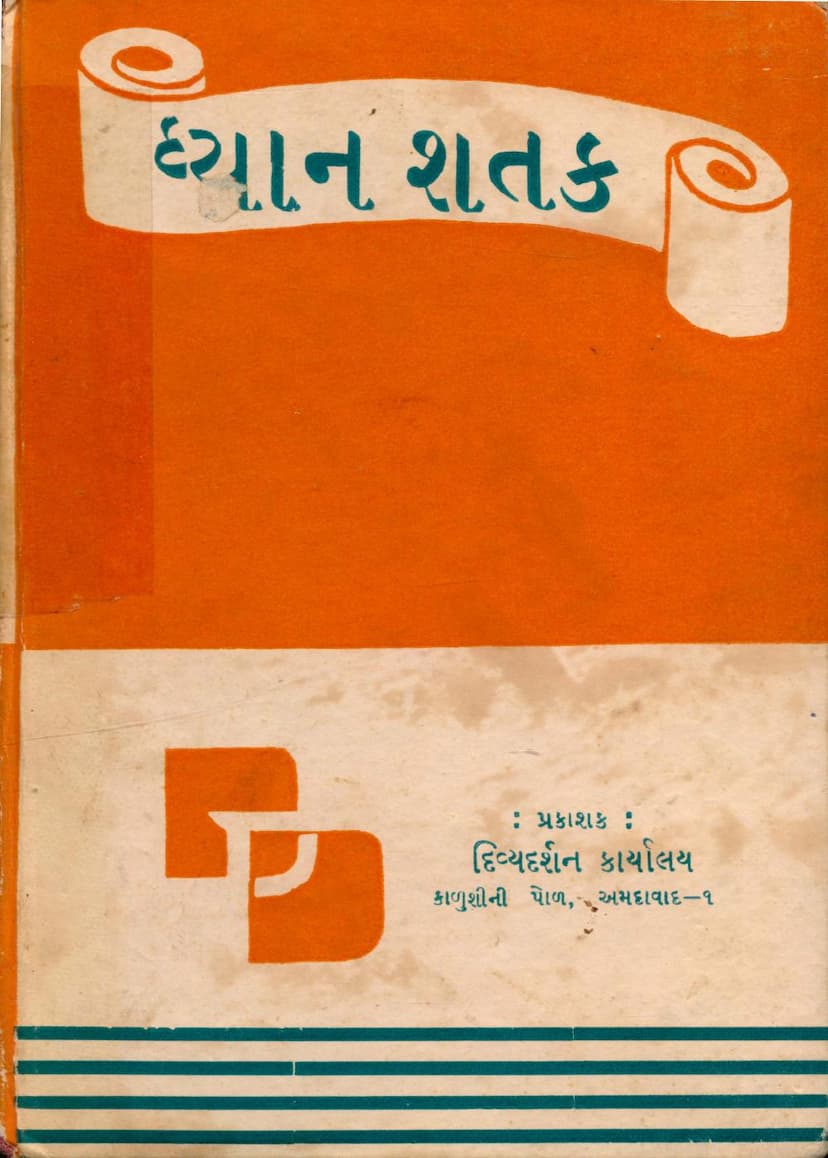Dhyan Shatak
Added to library: September 1, 2025

Summary
Here's a comprehensive summary of the Jain text "Dhyan Shatak" based on the provided pages:
Title: Dhyan Shatak (A Century of Meditation) Author: Jinbhadra Gani Kshamashraman Commentator: Acharya Haribhadrasuri (Sanskrit Commentary) Gujarati Translation & Exposition: Panhyas Shri Bhanuvijayji Ganivar (Disciple of Acharya Shri Vijay Premsurishvarji) Publisher: Divyadarshan Karyalay, Ahmedabad
Core Subject: The Dhyan Shatak is a foundational Jain text that delves deeply into the nature, types, and practice of meditation ('Dhyana'). It aims to guide individuals towards spiritual upliftment and liberation by understanding and mastering the mind.
Key Concepts and Structure:
The text begins with an introduction by the publisher, highlighting the importance of "Dhyan Shatak" as a guide for the four-fold Jain community (monks, nuns, male and female lay followers). It emphasizes its role in self-improvement, removing inner impurities, and revealing the path to liberation. The book is based on the Sanskrit commentary of Acharya Haribhadrasuri, making the original profound teachings accessible through Gujarati.
The core of the text, as explained in the 'Prastavana' (Preface) and detailed in the 'Vishayanukram' (Table of Contents), focuses on the power of the mind and its role in shaping one's destiny. It categorizes meditation into two main types:
- Ashubh Dhyan (Inauspicious Meditation): This includes Art Dhyan (meditation driven by pain and suffering) and Raudra Dhyan (meditation driven by anger, hatred, and violence).
- Shubh Dhyan (Auspicious Meditation): This comprises Dharma Dhyan (meditation focused on righteous principles and knowledge) and Shukla Dhyan (pure, luminous meditation leading to liberation).
The book systematically analyzes each type of meditation, detailing:
- Nature and Characteristics: What each type of meditation entails, its causes, and manifestations.
- Types and Sub-types: Differentiating the various forms within Art, Raudra, Dharma, and Shukla Dhyan.
- Fruits/Results: The consequences of engaging in each type of meditation, ranging from rebirth in lower realms for inauspicious dhyan to liberation for Shukla Dhyan.
- External Signs (Linga): Observable behaviors and emotional states that indicate the presence of a particular dhyan.
- Practitioners (Swami): Who is likely to engage in each type of dhyan.
- Methods and Practices: How to cultivate auspicious dhyan and avoid inauspicious ones.
Detailed Summary of Content:
- Introduction to Mind and Meditation: The text establishes the mind as the driver of actions and the source of happiness or suffering. It emphasizes that concentration on a subject is 'Dhyan'. The mind, controlled by the soul, has the power to lead one to salvation or hell.
- Art Dhyan (Grief/Pain Meditation):
- Nature: Arises from undesirable situations, loss of cherished things, pain, and suffering.
- Types: Focuses on contemplating the absence of the liked, presence of the disliked, and pain/illness, as well as the desire for future pleasures (Nidana).
- Causes: Sensory objects, suffering, attachment, and regret.
- Characteristics: Crying, lamenting, sighing, beating oneself, and dwelling on past losses or future fears.
- Results: Leads to rebirth in the animal realm.
- Raudra Dhyan (Fierce/Angry Meditation):
- Nature: Characterized by intense anger, violence, deceit, and malice.
- Types: Divided into four categories: violence-based, falsehood-based, theft-based, and protection-based (of property/possessions).
- Causes: Strong attachment to worldly possessions, intense anger, hatred, and desire for wealth.
- Characteristics: Fierce thoughts, harsh speech, violent actions, cruelty, and lack of compassion.
- Results: Leads to rebirth in hellish realms.
- Dharma Dhyan (Righteous Meditation):
- Nature: Meditation based on righteous principles, knowledge, and understanding of reality.
- Types: Analyzed through 12 'Dwar' (doors/aspects): contemplation of the nature of existence, the soul, the universe, auspiciousness, knowledge, correct conduct, detachment, spiritual effort, scripture, aspiration, inner purity, and the merits of the liberated soul.
- Key Practices: Cultivating faith in Jain scriptures (Agama), seeking guidance from enlightened teachers, studying the virtues of the Tirthankaras and saints, practicing compassion, and understanding the impermanence of worldly things.
- Results: Leads to heavenly births and progress on the spiritual path.
- Shukla Dhyan (Pure Meditation):
- Nature: The highest form of meditation, leading to the destruction of karma and liberation. It is characterized by extreme purity of thought and detachment.
- Types: Described in four stages:
- Prithaktva Vitarka-Savichara: Contemplation of subtle objects, involves discriminating thought.
- Ekattva Vitarka-Avichara: Contemplation of a single object without switching thoughts.
- Sukshma Kriya-Anivritti: Subtle meditation where external actions cease, and internal processes continue.
- Vyucchinn-Kriya-Apratipati: Complete cessation of all actions and yogic activity, leading to liberation.
- Practitioners: Primarily attained by advanced souls, culminating in Kevalis (omniscient beings) who reach the final stages.
- Results: Leads to the destruction of all karma and attainment of Kevala Jnana (omniscience) and Moksha (liberation).
Emphasis on Mind Control:
Throughout the text, the profound influence of the mind is stressed. The ability to control thoughts, direct them towards auspicious subjects, and achieve unwavering concentration is presented as the key to spiritual progress. The text clarifies how to overcome negative mental states and cultivate positive ones, ultimately leading to the purification of the soul.
The Role of Ascetic Practices:
The text also highlights the importance of practices like fasting (Anshan), discipline (Sanyam), and virtuous conduct (Sheel) as they aid in the meditative process and facilitate karma destruction.
Accessibility and Purpose:
The Gujarati exposition aims to make the complex philosophical and practical aspects of Jain meditation understandable to a broad audience, enabling them to apply these principles in their lives for spiritual benefit and ultimately, for the attainment of liberation. The 'Prastavana' and 'Vishayanukram' indicate a structured approach to explaining the multifaceted nature of dhyana, making it a comprehensive guide.
In essence, "Dhyan Shatak" is presented as a vital scripture for understanding and practicing meditation within the Jain tradition, offering a path from worldly suffering to ultimate spiritual freedom through diligent mental cultivation.